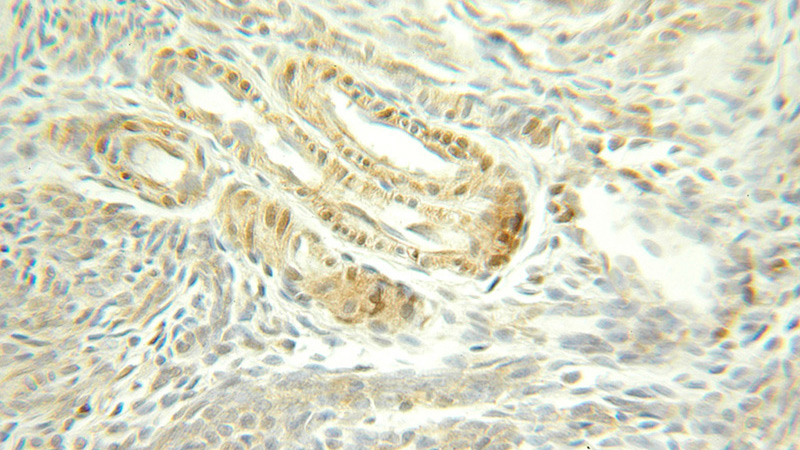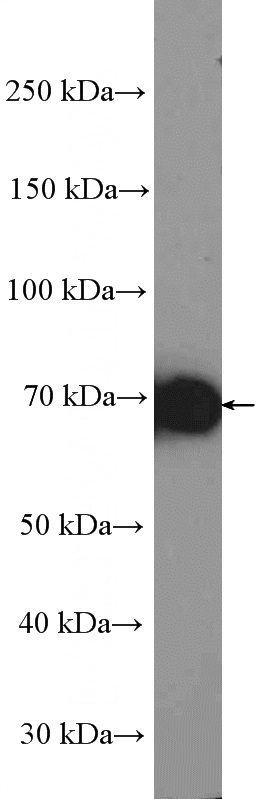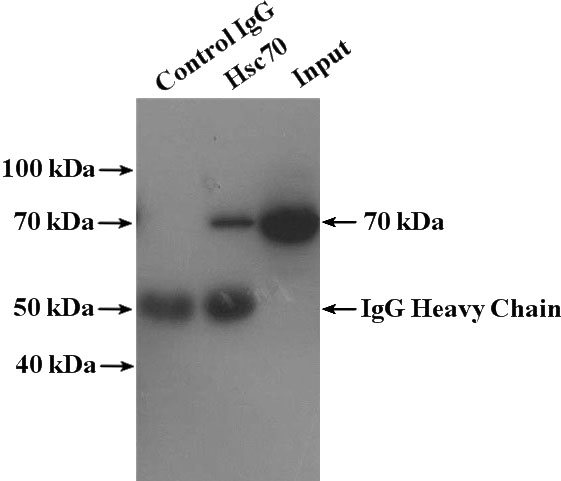-
Product Name
Hsc70 antibody
- Documents
-
Description
Hsc70 Rabbit Polyclonal antibody. Positive IP detected in HEK-293 cells. Positive WB detected in HEK-293 cells, A431 cells, C6 cells, COLO 320 cells, HeLa cells, HepG2 cells, MCF7 cells, NIH/3T3 cells, rat brain tissue. Positive IHC detected in human ovary tumor tissue, human gliomas tissue. Observed molecular weight by Western-blot: 70-73 kDa
-
Tested applications
ELISA, IHC, IP, WB
-
Species reactivity
Human,Mouse,Rat; other species not tested.
-
Alternative names
HSC54 antibody; HSC70 antibody; HSC71 antibody; HSP71 antibody; HSP73 antibody; HSPA10 antibody; HSPA8 antibody
-
Isotype
Rabbit IgG
-
Preparation
This antibody was obtained by immunization of Hsc70 recombinant protein (Accession Number: BC007276). Purification method: Antigen affinity purified.
-
Clonality
Polyclonal
-
Formulation
PBS with 0.1% sodium azide and 50% glycerol pH 7.3.
-
Storage instructions
Store at -20℃. DO NOT ALIQUOT
-
Applications
Recommended Dilution:
WB: 1:1000-1:10000
IP: 1:200-1:2000
IHC: 1:20-1:200
-
Validations

Immunohistochemical of paraffin-embedded human ovary tumor using Catalog No:111472(HSPA8 antibody) at dilution of 1:100 (under 25x lens)

HEK-293 cells were subjected to SDS PAGE followed by western blot with Catalog No:111472(Hsc70 Antibody) at dilution of 1:2000

IP Result of anti-Hsc70 (IP:Catalog No:111472, 4ug; Detection:Catalog No:111472 1:800) with HEK-293 cells lysate 3680ug.
-
Background
HSPA8 (also known as HSC70) is a member of the HSPA (HSP70) family of heat-shock proteins which are highly conserved chaperons implicated in protein folding, protein refolding, protein transport, and protein targeting. HSPA8 is a constitutively expressed cytosol/nuclear protein able to translocate between cytoplasm and nucleus. Recently it has been reported that HSPA8 can interact with α-synuclein, the critical pathological protein of Parkinson’s disease, indicating its implication in neurodegenerative disease. (21832061)
-
References
- Han B, Zhou H, Jia G. MAPKs and Hsc70 are critical to the protective effect of molecular hydrogen during the early phase of acute pancreatitis. The FEBS journal. 283(4):738-56. 2016.
- Su CC, Su JH, Lin JJ. An investigation into the cytotoxic effects of 13-acetoxysarcocrassolide from the soft coral Sarcophyton crassocaule on bladder cancer cells. Marine drugs. 9(12):2622-42. 2011.
- Liu CI, Wang RY, Lin JJ. Proteomic profiling of the 11-dehydrosinulariolide-treated oral carcinoma cells Ca9-22: effects on the cell apoptosis through mitochondrial-related and ER stress pathway. Journal of proteomics. 75(18):5578-89. 2012.
- Wang BS, Yang Y, Yang H. PKCι counteracts oxidative stress by regulating Hsc70 in an esophageal cancer cell line. Cell stress & chaperones. 18(3):359-66. 2013.
- Vakifahmetoglu-Norberg H, Kim M, Xia HG. Chaperone-mediated autophagy degrades mutant p53. Genes & development. 27(15):1718-30. 2013.
- Ma J, Hu Y, Guo M, Huang Z, Li W, Wu Y. hERG potassium channel blockage by scorpion toxin BmKKx2 enhances erythroid differentiation of human leukemia cells K562. PloS one. 8(12):e84903. 2013.
- Liu YZ, Jiang YY, Wang BS. A panel of protein markers for the early detection of lung cancer with bronchial brushing specimens. Cancer cytopathology. 122(11):833-41. 2014.
- Liu C, Lin JJ, Yang ZY, Tsai CC, Hsu JL, Wu YJ. Proteomic study reveals a co-occurrence of gallic acid-induced apoptosis and glycolysis in B16F10 melanoma cells. Journal of agricultural and food chemistry. 62(48):11672-80. 2014.
Related Products / Services
Please note: All products are "FOR RESEARCH USE ONLY AND ARE NOT INTENDED FOR DIAGNOSTIC OR THERAPEUTIC USE"
